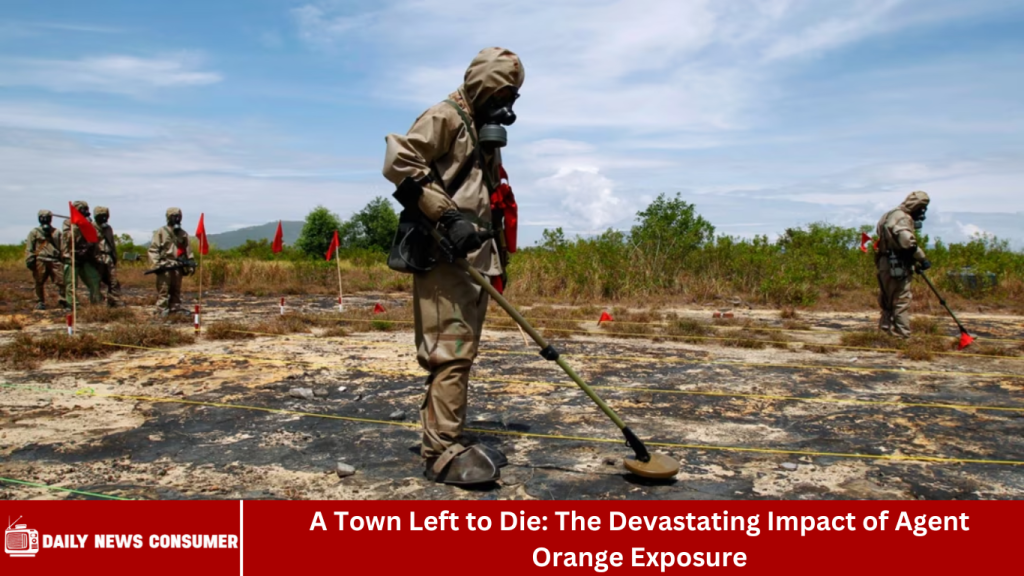Hi everyone! How are you all doing? Welcome to www.dailynewsconsumer.com! For decades, the U.S. government assured Americans that the toxic herbicide Agent Orange was only a danger to those exposed overseas during the Vietnam War. But for the residents of one small American town, the nightmare of Agent Orange contamination hit much closer to home—turning their community into a toxic wasteland riddled with cancer, birth defects, and death.
This is the story of how a military chemical meant for foreign jungles seeped into the soil, water, and lives of an unsuspecting American town—and how the government turned its back on the people it poisoned.
The Toxic Secret in Their Backyards
The town of Times Beach, Missouri, was once a quiet riverside community—until the 1970s, when a waste hauler sprayed its dirt roads with dioxin-laced oil to control dust. That oil contained toxic byproducts from Agent Orange production, one of the most dangerous chemicals ever created.
Residents had no idea they were walking, playing, and breathing in a known carcinogen until horses, pets, and children began falling ill. By the time the EPA stepped in, the damage was irreversible. In 1983, the federal government evacuated and demolished the entire town, declaring it uninhabitable.
But Times Beach wasn’t the only place poisoned. Other communities near Agent Orange manufacturing plants and storage sites—from Nitro, West Virginia, to Newark, New Jersey—have faced similar fates, with generations suffering from rare cancers, neurological disorders, and horrific birth defects.
The Lingering Horror of Agent Orange Exposure
Agent Orange was a defoliant used by the U.S. military to destroy jungles during the Vietnam War. But its most dangerous component, TCDD dioxin, is one of the most toxic substances ever studied—linked to:
- Cancer (leukemia, lymphoma, prostate, lung, and soft tissue sarcomas)
- Severe birth defects (spina bifida, cleft palate, missing limbs)
- Neurological disorders (Parkinson’s disease, peripheral neuropathy)
- Immune system damage and autoimmune diseases
While Vietnam veterans eventually won compensation for their exposure, civilians living near U.S. production sites were left behind—many still fighting for recognition and medical care.
Frequently Asked Question
How did Agent Orange end up poisoning American towns?
During and after the Vietnam War, chemical companies like Monsanto and Dow produced millions of gallons of Agent Orange. Waste from this production was dumped, stored improperly, or even repurposed as “recycled oil” for dust control—leading to contamination in towns like Times Beach.
Why was Times Beach completely abandoned?
In 1982, tests revealed dioxin levels 300 times higher than the safety threshold. The EPA declared a federal emergency, buying out all 2,000 residents and demolishing every building. The site was later turned into a wildlife refuge.
Are other towns still contaminated?
Yes. Nitro, West Virginia (home to a Monsanto plant) and Newark, New Jersey (where Agent Orange was stored) still report elevated cancer rates and birth defects. Many sites were never fully cleaned.
Did the government know about the risks?
Internal documents show that chemical companies knew dioxin was deadly as early as the 1960s but downplayed risks. The EPA only took action after public outcry.
Have victims received compensation?
Some Vietnam veterans won legal battles for healthcare, but civilians exposed in the U.S. have been largely ignored. A few lawsuits succeeded, but most victims never saw justice.
Is the contamination still dangerous today?
Dioxin does not break down easily—it remains in soil and waterways for decades. Some former hotspots are still officially unsafe for long-term exposure.
What can be done now?
Advocates demand:
- Expanded medical coverage for affected civilians
- Thorough cleanup of remaining sites
- Declassified records on government and corporate knowledge of the dangers
Conclusion
The story of the town left to die is not just a tale of environmental catastrophe—it is a haunting reminder of the long-term human cost of chemical warfare. The impact of Agent Orange exposure has extended far beyond the battlefield, infiltrating the lives, bodies, and futures of entire communities. Decades after the last spray, residents continue to suffer from chronic illness, birth defects, and ecological destruction, with little accountability or support. This tragedy underscores the urgent need for environmental justice, comprehensive healthcare for affected populations, and a global commitment to preventing similar atrocities in the future. The scars of Agent Orange serve as a warning: when profit, power, and war take precedence over human life, it is the innocent who pay the price.

